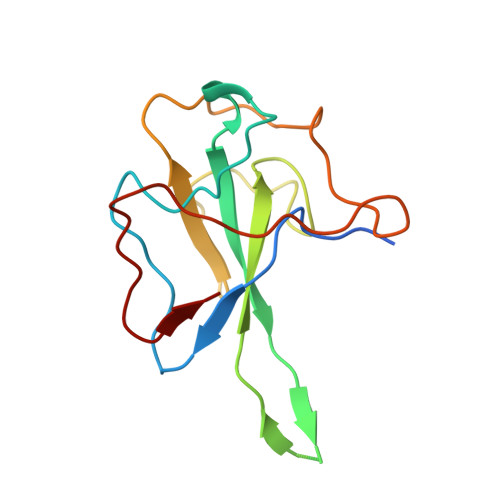
Top ▲

GtoPdb is requesting financial support from commercial users. Please see our sustainability page for more information.
Gene and Protein Information  |
||||||
| Species | TM | AA | Chromosomal Location | Gene Symbol | Gene Name | Reference |
| SARS-CoV-2 | - | 419 | Orf14 | N | nucleocapsid protein | |
| SARS-CoV | - | 422 | Orf14 | N | nucleocapsid protein | |
Previous and Unofficial Names  |
| nucleocapsid phosphoprotein |
Database Links  |
|
| Entrez Gene | 43740575 (SARS-CoV-2), 1489678 (SARS-CoV) |
| RefSeq Protein | YP_009825061 (SARS-CoV), YP_009724397 (SARS-CoV-2) |
| UniProtKB | P0DTC9 (SARS-CoV-2), P59595 (SARS-CoV) |
Selected 3D Structures  |
|||||||||||

|
|
||||||||||
| General Comments |
|
The coronavirus nucleocapsid phosphoprotein (N, or nucleoprotein) is highly basic and binds the viral RNA as a dimeric entity [1] into nucleocapsids which protect the viral genome, while also providing access for replication when required. Of three targets suggested to associate with SARS-CoV-2 N phosphoprotein (in a cell-free system [2]), G3BP1 (G3BP stress granule assembly factor 1; UniProt accession Q13283) seems a relevant focus for therapy against COVID-19. G3BP1 regulates the innate immune response [4,6,9-10] and stress granules reduce the replication of MERS-CoV [8], so there is potential here for targeted drug discovery. SARS-CoV-2 N phosphoprotein has been shown to directly associate with host gasdermin D (GSDMD; P57764) [7]. GSDMD is a component of inflammasomes and it is required for the secretion of IL-1β (type I interferon response) and for triggering pyroptosis (immunogenic cell death) [3,5]; this represents the normal response to viral infection. GSDMD/N binding circumvents this cellular immune response by blocking caspase-1-mediated GSDMD processing, which ultimately inhibits both IL-1β secretion and pyroptosis. |
1. Fan H, Ooi A, Tan YW, Wang S, Fang S, Liu DX, Lescar J. (2005) The nucleocapsid protein of coronavirus infectious bronchitis virus: crystal structure of its N-terminal domain and multimerization properties. Structure, 13 (12): 1859-68. [PMID:16338414]
2. Gordon DE, Jang GM, Bouhaddou M, Xu J, Obernier K, White KM, O'Meara MJ, Rezelj VV, Guo JZ, Swaney DL et al.. (2020) A SARS-CoV-2 protein interaction map reveals targets for drug repurposing. Nature, 583 (7816): 459-468. [PMID:32353859]
3. He WT, Wan H, Hu L, Chen P, Wang X, Huang Z, Yang ZH, Zhong CQ, Han J. (2015) Gasdermin D is an executor of pyroptosis and required for interleukin-1β secretion. Cell Res, 25 (12): 1285-98. [PMID:26611636]
4. Kim SS, Sze L, Liu C, Lam KP. (2019) The stress granule protein G3BP1 binds viral dsRNA and RIG-I to enhance interferon-β response. J Biol Chem, 294 (16): 6430-6438. [PMID:30804210]
5. Liu X, Zhang Z, Ruan J, Pan Y, Magupalli VG, Wu H, Lieberman J. (2016) Inflammasome-activated gasdermin D causes pyroptosis by forming membrane pores. Nature, 535 (7610): 153-8. [PMID:27383986]
6. Liu ZS, Cai H, Xue W, Wang M, Xia T, Li WJ, Xing JQ, Zhao M, Huang YJ, Chen S et al.. (2019) G3BP1 promotes DNA binding and activation of cGAS. Nat Immunol, 20 (1): 18-28. [PMID:30510222]
7. Ma J, Zhu F, Zhao M, Shao F, Yu D, Ma J, Zhang X, Li W, Qian Y, Zhang Y et al.. (2021) SARS-CoV-2 nucleocapsid suppresses host pyroptosis by blocking Gasdermin D cleavage. EMBO J, 40 (18): e108249. [PMID:34296442]
8. Nakagawa K, Narayanan K, Wada M, Makino S. (2018) Inhibition of Stress Granule Formation by Middle East Respiratory Syndrome Coronavirus 4a Accessory Protein Facilitates Viral Translation, Leading to Efficient Virus Replication. J Virol, 92 (20). [PMID:30068649]
9. Wiser C, Kim B, Ascano M. (2019) G3BP1 enhances cytoplasmic DNA pattern recognition. Nat Immunol, 20 (1): 5-7. [PMID:30538338]
10. Yang W, Ru Y, Ren J, Bai J, Wei J, Fu S, Liu X, Li D, Zheng H. (2019) G3BP1 inhibits RNA virus replication by positively regulating RIG-I-mediated cellular antiviral response. Cell Death Dis, 10 (12): 946. [PMID:31827077]